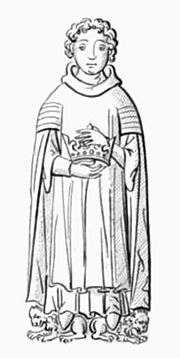Herigaut

Charles, 6th Dauphin, from his tomb effigy. He is wearing a herigaut with tucked sleeves.
A herigaut is a gown-like garment worn in the thirteenth and early fourteenth centuries.[1] Alternative spellings include herigald, heregaud, gerygoud and herigans.[1] It was three-quarters to full length with hanging sleeves.[1] Sometimes the sleeves were tucked at the top to increase fullness below.[2] Although it was primarily a men's garment, women occasionally wore it as well.[2] Along with the garnache, it is a variant of the garde-corps,[3] and it is also related to the houppelande.[4]
References
- 1 2 3 Cumming, Valerie; Cunnington, C.W.; Cunnington, P.E. (2010). The dictionary of fashion history (Rev., updated ed.). Oxford: Berg. p. 103. ISBN 9781847885333.
- 1 2 Evans, Joan (1952). Dress in mediaeval France. Clarendon Press. p. 19.
- ↑ Fabre, Maurice (1966). History of fashion. Edito-Service. p. 24.
- ↑ Howell, Lauren. "Early Gothic-13th & 14th Centuries". Illinois State University. Archived from the original on 9 August 2012. Retrieved 18 July 2013.
This article is issued from
Wikipedia.
The text is licensed under Creative Commons - Attribution - Sharealike.
Additional terms may apply for the media files.